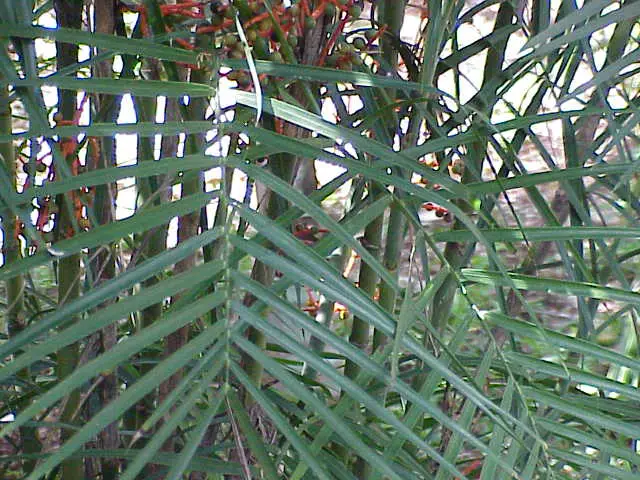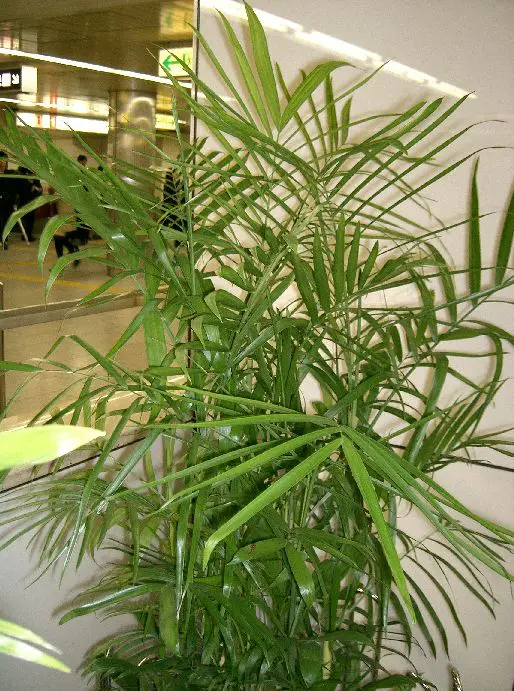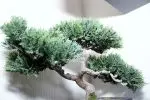This post contains affiliate links. If you buy something from one of our links we may earn a commission. Thanks

Bamboo palm indoor care involves placing the plant in bright, indirect light, watering it to keep the soil moist but not waterlogged, and using a well-draining soil mix.
It’s beneficial to fertilize every two to three months during the growing season and ensure a humidity level between 40-60% for optimum growth and health.
Welcome to the world of bamboo palm indoor care! This gorgeous tropical plant not only adds a touch of greenery to your home decor but also has numerous health benefits.
From choosing the right soil mix to providing adequate lighting, we’ve got you covered with tips and tricks to help your bamboo palm thrive.
So, grab your gardening gloves, and let’s get started!
I. The Bamboo Palm (Chamaedorea seifrizii)
Hey there plant enthusiasts! If you’re looking to add a bit of tropical flair to your indoor space, Chamaedorea seifrizii, also known as the bamboo palm, is a fantastic choice.
This elegant plant not only looks great but also has a number of benefits for your home environment.
Whether you’re a seasoned green thumb or a newbie to plant care, this guide will provide you with all the necessary information to care for your bamboo palm and help it thrive in its new home.
So, let’s dive in!
What Is the Bamboo Palm

Bamboo palms, scientifically known as Chamaedorea seifrizii, are beautiful tropical plants that are native to Central America and South America.
It is an attractive and popular houseplant due to its graceful appearance and its ability to purify the air by removing toxins such as benzene and formaldehyde.
The bamboo palm has slender stems that resemble bamboo, and it produces lush, green fronds that add a touch of natural beauty to any room and make them popular houseplants.
They are not true bamboo plants they are palm trees. It is related to the parlor palm plant chamaedorea elegans and similar in care.
Chamaedorea seifrizii vs Chamaedorea elegans the differences
Chamaedorea seifrizii and Chamaedorea elegans are two different species of bamboo palm, although they are sometimes confused with each other due to their similar appearance.
Here are some of the main differences between the two:
Size: Chamaedorea seifrizii is typically larger than Chamaedorea elegans, growing up to 8-10 feet tall, while Chamaedorea elegans usually grow up to 6-7 feet tall.
Leaflets: The leaflets on Chamaedorea seifrizii are more pointed and have a slightly arching shape, while the leaflets on Chamaedorea elegans are more rounded and have a straighter shape.
Stem: The stem of Chamaedorea seifrizii is usually thicker and more robust than the stem of Chamaedorea elegans.
Hardiness: Chamaedorea elegans is more cold-hardy than Chamaedorea seifrizii and can withstand temperatures as low as 20 degrees Fahrenheit.
Light requirements: Chamaedorea elegans is more tolerant of low light conditions than Chamaedorea seifrizii, which prefers bright, indirect light.
Overall, both species of bamboo palm are relatively easy to care for and have similar growth habits.
However, their differences in size, leaflets, stem, hardiness and light requirements may influence which species is better suited for a particular location or purpose.
Reasons for Growing Bamboo Palm Indoors and Outdoors
There are several reasons to grow bamboo palms indoors and outdoors.
Indoors, it is an excellent plant for adding a touch of natural beauty to your home decor, purifying the air, and boosting your overall health and well-being.
Outdoors, the bamboo palm is perfect for creating a tropical oasis in your backyard or patio, providing shade, and improving air quality in the surrounding area.
Benefits of Indoor and Outdoor Bamboo Palm Care
There are numerous benefits to caring for bamboo palm plants, whether you choose to grow them indoors or outdoors.
Indoor bamboo palm care can help purify the air in your home, reducing the risk of respiratory problems, allergies, and other health issues.
It can also enhance the aesthetic appeal of your living space and boost your mood and productivity.
Outdoor bamboo palm care can help create a relaxing and inviting outdoor space, reduce noise pollution, and enhance the visual appeal of your landscape.
Additionally, caring for bamboo palm plants can provide a fun and rewarding hobby that improves your mental and physical well-being.
II.Bamboo Palm Indoor Care: Planting and Potting
Welcome to the planting and potting section of our bamboo palm indoor care guide!
Choosing the right potting mix and container for your bamboo palm is essential for its growth and overall health.
Whether you’re a seasoned gardener or a newbie to plant care, we’ve got you covered with all the necessary information you need to know about planting and potting your bamboo palm.
So, let’s get our hands dirty and dive right in!
Choosing the Right Soil Mix for Bamboo Palm
Selecting the right soil mix for your new plants is crucial for their overall health and growth.
Since the bamboo palm is a tropical plant, it requires well-draining soil that retains moisture. But it won’t tolerate soggy soil well.
You can opt for a good-quality potting mix that contains peat moss or perlite for drainage, as well as vermiculite or coconut coir to retain moisture.
Avoid using heavy clay soil, as it can lead to waterlogged roots and ultimately harm your plant.
Selecting the Perfect Pot Size and Type for Bamboo Palm
Choosing the right pot size and type is also essential for the well-being of your bamboo palm.
The pot should be slightly larger than the root ball of your plant, with enough space for the roots to spread out.
You can choose a ceramic or terracotta pot but make sure it has a drainage hole that allows for proper drainage and prevents water from pooling at the bottom.
Ensure that the pot has drainage holes to prevent waterlogging, and holding too much water which can lead to root rot.
Planting the Bamboo Palm Indoors and Outdoors Using Coco Coir for the Soil Mix
When planting your bamboo palm, start by filling the pot with your chosen soil mix.
As mentioned earlier, using a soil mix that contains coconut coir is an excellent option as it is an eco-friendly alternative to peat moss or peat-based soil mixes.
Coconut coir is a byproduct of the coconut industry and is sustainable and renewable.
Place your bamboo palm in the pot and fill the remaining space with soil mix, ensuring that the plant is level with the soil surface.
Water thoroughly and allow the excess water to drain out of the pot.
If planting outdoors, ensure that your bamboo palm is in a shaded area that receives dappled sunlight, as direct sunlight can scorch the leaves.
Why coconut coir is a better more environmentally friendly alternative
Coconut coir is an excellent alternative to peat moss or peat-based soil mixes.
Unlike peat moss, which is harvested from natural peat bogs, coconut coir is a byproduct of the coconut industry and is sustainable and renewable.
Peat bogs are a vital ecosystem that provides important ecological services such as carbon storage, water regulation, and habitat for wildlife.
However, peat extraction for horticultural purposes can lead to habitat destruction, carbon emissions, and the release of stored carbon into the atmosphere.
Coconut coir, on the other hand, is a renewable resource that is harvested from the outer husk of coconuts.
The husk is processed to remove the fiber, which is then washed, sterilized, and often compressed into bricks or blocks.
Coconut coir has excellent water retention properties, which make it an ideal soil amendment for plants that require moist soil.
It also has a neutral pH and is free of pathogens, weeds, and pests.
Moreover, coconut coir is a more environmentally friendly option as it is a waste product that would otherwise be discarded, and it is readily available in tropical regions where coconuts are grown.
Overall, using coconut coir as a soil mix for your bamboo palm is an excellent choice for plant health and environmental sustainability.
It is an eco-friendly alternative to peat moss or peat-based soil mixes that are often associated with environmental concerns.
By using coconut coir, you can ensure that your bamboo palm thrives while also minimizing your impact on the environment.
III. Watering and Humidity
If you’re looking to care for your bamboo palm, watering, and humidity are essential factors to consider.
The Chamaedorea seifrizii, or bamboo palm, is a tropical plant that requires consistent moisture levels to thrive.
Ensuring that your bamboo palm gets the right amount of water and humidity can help keep it healthy and lush.
In this section, we’ll explore the best watering practices for your bamboo palm and how to create the ideal humidity levels. So, let’s dive in!
Watering frequency for bamboo palm indoors and outdoors:
Bamboo palms require consistent moisture levels, but it’s essential not to overwater them.
Overwatering can lead to root rot and other plant diseases.
It’s best to water the bamboo palm once a week during the growing season and reduce the frequency during the winter months.
When watering, make sure the soil is moist but not soggy.
The amount of water you use will depend on the size of the pot and the humidity levels in your home.
Watering from the bottom is an effective way to ensure that the roots get enough water without saturating the soil.
Simply fill a tray with water and place the pot on top, allowing the plant to soak up the water from the bottom.
Importance of humidity for bamboo palm indoor care:
Bamboo palms are native to humid tropical regions, which means they require a relatively high level of humidity to thrive.
Dry air can cause the leaves to turn brown and brittle, making the plant look unsightly.
It can also lead to pest infestations and disease. Therefore, it’s important to keep the humidity levels between 40-60% for your bamboo palm.
How to increase humidity levels for indoor bamboo palm care:
There are several ways to increase humidity levels for your indoor bamboo palm.
One of the most effective ways is to use a humidifier, which adds moisture to the air and helps maintain the ideal humidity level.
Another option is to place a tray of water near the plant, allowing the water to evaporate and create moisture in the air.
You can also set your plant on a pebble tray.
Misting the leaves with water is also an effective way to increase humidity levels temporarily.
Finally, grouping your plants together can create a mini-humid microclimate for your plants.
Avoid placing your plants near heating or air conditioning vents that produce dry air.
IV. Light and Temperature
The right amount of light and temperature can make all the difference when it comes to caring for your bamboo palm.
This tropical plant requires adequate light to thrive, but too much direct sunlight can be harmful.
Temperature is also a critical factor in the plant’s growth and health, and it’s important to maintain a consistent temperature range.
In this section, we’ll explore the best lighting and temperature practices for your bamboo palm, both indoors and outdoors. So, let’s get started!
Optimal light conditions for bamboo palm indoors and outdoors:
Bamboo palms thrive in bright indirect light. When growing indoors, it’s best to place the plant near a window that receives bright but filtered light.
Too much direct sunlight can scorch the leaves and damage the plant.
When growing outdoors, it’s best to place the plant in partial shade, such as under a tree or near a shaded area.
Effects of low light and how to address it for indoor bamboo palm care:
Low light can be detrimental to bamboo palms, causing the leaves to turn yellow and the plant to become leggy.
If you notice these symptoms, it’s crucial to take action promptly. One way to address low light is to move the plant to a brighter location.
Another option is to use grow lights to supplement the natural light. Grow lights can provide the necessary light spectrum for plant growth and development.
Temperature requirements and tips for maintaining them for outdoor bamboo palm care:
Bamboo palms require a warm and humid environment to thrive.
When growing outdoors, it’s best to plant the bamboo palm in a sheltered area where it’s protected from strong winds and harsh temperatures.
The plant prefers temperatures between 60-80°F (16-27°C) during the day and 50-65°F (10-18°C) at night.
If temperatures drop below 50°F (10°C), the plant may suffer damage, and its growth may slow down.
To maintain a consistent temperature range, you can use a greenhouse or cover the plant with a cloth during colder periods.
V. Fertilizing and Pruning
Fertilizing and pruning are essential practices for bamboo palm indoor care to keep your bamboo palm healthy and looking its best.
By providing the right nutrients and pruning the plant regularly, you can encourage new growth and maintain its shape.
In this section, we’ll cover the best ways to fertilize and prune your bamboo palm, both indoors and outdoors.
Whether you’re a beginner or an experienced gardener, these tips will help you keep your plant thriving.
So, let’s dive in and learn more about bamboo palm fertilizing and pruning!
Appropriate fertilizer for bamboo palm care:
When it comes to fertilizing your bamboo palm, it’s best to use a balanced, water-soluble fertilizer that contains equal parts nitrogen, phosphorus, and potassium.
You can find these fertilizers at your local garden center or online.
It’s crucial to use a fertilizer that’s specifically designed for indoor plants if you’re growing the bamboo palm indoors.
These fertilizers have a lower concentration of nutrients, which is suitable for indoor growing conditions.
Timing and frequency of fertilizing:
Bamboo palms require frequent fertilization to thrive, especially during the growing season.
The best time to fertilize your plant is in the spring and summer when the plant is actively growing.
During this time, you can fertilize your bamboo palm every four to six weeks.
During the fall and winter months, you can reduce the frequency to every eight to ten weeks.
Be sure to follow the instructions on the fertilizer package, as over-fertilization can harm the plant.
Pruning techniques for maintaining the bamboo palm’s shape:
Pruning is an essential part of bamboo palm care, as it helps to maintain the plant’s shape and encourages new growth.
When pruning the plant, it’s best to use a clean pair of scissors or pruning shears to avoid spreading diseases.
To prune the bamboo palm, simply cut back any dead or yellowing leaves at the base of the stem.
You can also trim back any stems that are growing too long or have become leggy.
Be sure to maintain a balanced shape by pruning the plant evenly on all sides.
With these simple pruning techniques, you can keep your bamboo palm looking healthy and attractive.
Slow-release fertilizer spikes:
Another option for fertilizing your bamboo palm is to use slow-release fertilizer spikes.
These spikes are inserted into the soil and slowly release nutrients over several months, providing a consistent source of food for your plant.
They’re convenient and easy to use, making them a popular choice among gardeners.
You can find slow-release fertilizer spikes at most garden centers or online.
Be sure to follow the instructions on the package, as the number of spikes required will depend on the size of your plant.
Slow-release fertilizer spikes are a great way to simplify your bamboo palm care routine and keep your plant healthy and thriving.
The use of tree spikes will take the guesswork out of fertilizing. Here is what I recommend for  fertilizing your bamboo palm.
fertilizing your bamboo palm.
I recommend using Jobes Organics fertilizer spikes.
They are easy to use and last for 2-3 months.
They are designed for container-grown citrus.
They work really well for indoor palms in containers too.
Using 2 spikes for a 12-inch pot or 3 for an 18-inch pot takes the guesswork out of fertilizing.
They provide a 3-5-5 fertilizer blend along with micronutrients and beneficial bacteria.
VI. Common Problems and Solutions
We all want our plants to be healthy and vibrant, but sometimes issues can arise even with the best care.
In this section, we’ll go over some common problems you might encounter with your bamboo palm, both indoors and outdoors, and provide some solutions to help you get your plant back on track.
Remember, don’t get discouraged if you encounter some bumps in the road – with a little bit of knowledge and effort, you can keep your bamboo palm looking beautiful and healthy.
Pest and disease prevention and management:
Prevention is the key to avoiding pest and disease issues with your bamboo palm.
Make sure you’re not overwatering your plant, as excess moisture can lead to fungal and bacterial diseases.
Keep an eye out for common pests like spider mites and mealybugs, which can damage the leaves and stems of your plant.
Regularly inspecting your plant can help you catch any issues early on and prevent them from spreading.
Symptoms and treatment of common issues:
One common problem that indoor bamboo palms can experience is brown leaves and leaf tips.
This can be caused by a variety of factors, such as over or underwatering, low humidity levels, or a lack of fertilizer.
If you notice brown tips on your plant, try adjusting your watering schedule or adding a humidifier to increase the moisture levels in the air.
You can also fertilize your plant with a balanced fertilizer to provide it with the nutrients it needs.
Tips for troubleshooting and correcting problems:
If you encounter any issues with your bamboo palm, don’t panic! With a bit of troubleshooting, you can usually identify the problem and find a solution.
For example, if your plant is looking droopy and wilted, it may be a sign of underwatering. Try giving it a good soak and see if it perks back up.
If you notice yellowing leaves, it could be a sign of nutrient deficiencies, and fertilizing may help.
By paying attention to your plant’s symptoms and making adjustments as needed, you can keep your bamboo palm healthy and thriving.
Common insect pests and treatment methods
Despite being relatively hardy, bamboo palms are still susceptible to a variety of insect pests.
Some of the most common include spider mites, mealybugs, and scale insects.
Spider mites are tiny pests that can cause the leaves of the bamboo palm to turn yellow and develop a mottled appearance.
To treat them, try washing the leaves with a gentle soap and water solution or using insecticidal soap.
Mealybugs are small, soft-bodied insects that feed on the sap of the bamboo palm, causing stunted growth and yellowing of the leaves.
They can be treated with a neem oil or insecticidal soap spray, or by wiping them off the leaves with a cotton swab dipped in rubbing alcohol.
Scale insects can also be a problem, particularly on outdoor bamboo palms. They are small, brown, or black bumps on the stems or leaves of the plant.
To treat them, wipe them off with a soft cloth or cotton swab dipped in rubbing alcohol.
You may also need to use an insecticidal soap or neem oil spray to get rid of them completely.
VII. Bamboo Palm Benefits
Are you aware of the benefits that come with having a bamboo palm plant in your home or garden?
In this section, we’ll discuss the advantages of having a bamboo palm, from air purification to stress reduction.
With the increasing awareness of environmental health, adding a bamboo palm to your space is an excellent way to enhance your well-being.
So, let’s dive into the numerous benefits of the bamboo palm.
Air-purifying benefits of bamboo palm
One of the most significant benefits of having a bamboo palm in your home or garden is its ability to purify the air.
This plant can remove harmful toxins, such as formaldehyde and benzene, from the air, making it an excellent addition to any room in your house.
Plus, its lush green foliage can help increase the oxygen levels in your space, leading to better air quality and a healthier environment.
Aesthetic benefits of bamboo palms
Aside from its air-purifying abilities, the bamboo palm is also a stunning plant that can add a touch of tropical beauty to your home or garden.
With its feathery, arching leaves and slender stems, the bamboo palm is a fantastic choice for those who want to create a relaxing and tranquil environment.
Health benefits of having a bamboo palm around
Having a bamboo palm in your space can also have numerous health benefits.
For example, it can help reduce stress levels and boost your mood, leading to a more positive and productive day.
Additionally, the bamboo palm’s ability to purify the air can help alleviate symptoms of asthma, allergies, and other respiratory issues.
Plus, its relaxing and tranquil appearance can promote better sleep quality, leading to a more restful and rejuvenating night’s sleep.
VIII. Bamboo Palm Indoor Care Watering
Proper watering is crucial for the health and growth of your bamboo palm.
This section will cover everything you need to know about watering your plant, including how often and how much to water, the best methods for indoor and outdoor plants, and how to maintain the right levels of moisture in the soil.
Whether you’re a new or experienced plant parent, these tips will help you keep your bamboo palm thriving and looking its best. Let’s dive in!
Importance of proper watering for bamboo palm:
Watering is a crucial aspect of caring for bamboo palm plants.
They require a consistent supply of moisture, but overwatering can be just as harmful as underwatering.
Signs of overwatering and underwatering:
Overwatering can lead to root rot, which manifests as the yellowing and wilting of leaves, while underwatering causes leaves to turn brown and crispy.
Tips for watering bamboo palm and why tap water can be bad
To water bamboo palms correctly, always check the soil’s moisture level before watering and avoid using tap water, which contains chemicals harmful to the plant.
It’s best to use filtered or distilled water. Another trick is to use a container with drainage holes to prevent waterlogging, and watering once a week is enough.
IX. Bamboo Palm Light Requirements
The bamboo palm is a tropical plant that requires proper light conditions to thrive.
In this section, we’ll discuss the optimal light requirements for growing bamboo palms indoors and outdoors, as well as the effects of low light and how to address them.
Whether you’re a seasoned plant parent or just starting, this guide will help you ensure that your bamboo palm is getting the right amount of light to grow healthy and beautiful.
Light requirements for bamboo palm:
Bamboo palm thrives in bright, indirect light. Although it can tolerate lower light levels, it won’t grow as fast or lush in lower light conditions.
Ideally, it should receive four to six hours of bright, filtered sunlight per day.
Effects of inadequate lighting:
Insufficient light can cause your bamboo palm’s leaves to turn yellow or brown and drop off.
Additionally, it can result in slow growth or leggy, stretched-out stems.
Tips for providing sufficient light for bamboo palm:
To provide sufficient light for your bamboo palm, place it near a window with bright, indirect light or in a well-lit room.
If the light is too strong, you can use sheer curtains to filter it.
If you can’t provide enough natural light, consider using a grow light to supplement it.
X. Bamboo Palm Soil
Bamboo palm soil is an important aspect of the plant’s overall care.
The right soil mix can promote healthy root growth and prevent issues such as root rot.
One of the best options for soil is a mixture of coco coir and perlite.
This combination offers excellent drainage and aeration while also retaining moisture, making it an ideal choice for the bamboo palm.
In this section, we will delve into the specifics of choosing the right soil mix, pot size and type, and planting techniques for bamboo palm care.
Soil requirements for bamboo palm:
The right soil mix is essential for the healthy growth of the bamboo palm.
The soil should be well-draining and fertile, allowing air to circulate around the roots.
How to prepare soil for bamboo palm:
A mixture of coco coir and perlite is a great option for a bamboo palm soil mix.
Coco coir is an environmentally friendly alternative to peat moss that retains moisture well, while perlite helps improve drainage.
To prepare the soil, mix equal parts of coco coir and perlite, and add some organic fertilizer to provide nutrients.
Importance of proper drainage for bamboo palm:
Bamboo palm is susceptible to root rot when overwatered, which can be prevented by ensuring proper drainage.
Make sure that the pot has drainage holes and that excess water can flow out easily.
It’s also helpful to add a layer of gravel at the bottom of the pot to improve drainage.
XI. Bamboo Palm Outdoors
If you’re lucky enough to live in a warm, tropical climate, you can enjoy the beauty of a bamboo palm in your outdoor space.
Whether you want to add a touch of tropical flair to your patio, garden, or pool area, the bamboo palm is a great choice for its lush, graceful fronds and easy-care nature.
In this section, we’ll cover everything you need to know about growing and caring for bamboo palms outdoors, including light and temperature requirements, planting tips, and pest management strategies.
Suitable climate for outdoor bamboo palm:
Before planting your bamboo palm outdoors, it is essential to ensure that the climate in your area is suitable for this tropical plant.
Bamboo palm thrives in warm and humid conditions, with temperatures between 60°F and 80°F (15°C to 27°C). It is best suited for USDA hardiness zones 9-11.
Growing bamboo palm outdoors:
When selecting a planting spot for your bamboo palm, choose a location that receives bright light to partial shade.
Direct sunlight can cause the leaves to scorch, while too much shade can stunt growth.
Make sure the soil is well-draining, fertile, and rich in organic matter.
Plant your bamboo palm in a hole twice as wide and deep as the root ball, and backfill with a mixture of coco coir and perlite for optimal drainage.
Caring for bamboo palm outdoors:
Water your bamboo palm regularly, ensuring that the soil is evenly moist but not waterlogged.
Fertilize your plant with a slow-release granular fertilizer every three months during the growing season.
Keep an eye out for pests and diseases, and treat them promptly if necessary.
Prune your bamboo palm as needed to maintain its shape and remove any dead or damaged leaves.
Propagation
Bamboo palms can be propagated through division, seeds, or suckers. The most common method of propagation is division.
Here are some steps to propagate a bamboo palm:
Division
Choose a healthy parent plant that is at least three years old and has several stems.
Carefully remove the plant from its pot, and gently shake off any excess soil.
Use a sharp, clean knife or pruning shears to cut through the root ball and separate the individual stems.
Plant each stem in a new pot, using a well-draining soil mix.
Water the new plants thoroughly and keep them in a warm and humid environment, such as a greenhouse, to encourage root growth.
It’s important to note that newly propagated plants may take several months to establish themselves and begin to grow.
Seeds
Propagation of bamboo palm through seeds is possible, but it requires patience and may not always result in plants that are identical to the parent plant.
To propagate through seeds, collect mature seeds from the parent plant and sow them in a well-draining soil mix.
Keep the soil consistently moist and maintain a warm and humid environment to encourage germination.
Once the seedlings have grown large enough, they can be transplanted into individual pots.
If your plant is not making seeds you can buy Chamaedorea seifrizii seeds online.
Suckers
Propagation through suckers, also known as offsets, involves removing the small shoots that grow at the base of the parent plant.
Use a sharp, clean knife or pruning shears to carefully cut the sucker away from the parent plant.
Plant the sucker in a well-draining soil mix and keep it consistently moist. Suckers may take several months to establish themselves and begin to grow.
Propagation is a great way to expand your collection of bamboo palms and share them with friends and family.
It’s important to note that newly propagated plants require special care and attention, so be sure to monitor them closely and adjust your care routine as necessary.
XII. Bamboo Palm FAQs
Bamboo palms bring a tropical feel indoors, but like any plant, they have specific care needs.
From understanding the right lighting conditions to the frequency of watering and fertilization, these common questions aim to guide you in maintaining a thriving bamboo palm indoors.
Q. How often should I water my Bamboo Palm?
A. Water to keep the soil moist, usually once a week, adjusting in winter months.
Q. Does the Bamboo Palm need direct sunlight?
A. No, it thrives in bright, indirect light to prevent leaf scorch.
Q. How often should I fertilize my Bamboo Palm?
A. Every two to three months during the growing season with balanced fertilizer.
Q. Can I prune my Bamboo Palm?
A. Yes, prune to remove dead or yellowing fronds to maintain its appearance.
XIII. Bamboo Palm Indoor Care Conclusion
Congratulations on making it to the end of this comprehensive guide to bamboo palm care!
We hope that you now feel equipped with the knowledge and skills necessary to care for your indoor or outdoor bamboo palm successfully.
Remember, maintaining proper soil, light, water, and temperature conditions are crucial to ensuring your plant thrives.
Don’t hesitate to refer back to this guide if you need a refresher, and always feel free to experiment and adjust your care routine as needed.
With a little love and attention, your bamboo palm can provide you with its many benefits for years to come.
Summary of the key points discussed:
In this guide, we have covered all the essential aspects of growing and caring for the bamboo palm both indoors and outdoors.
We have discussed the ideal growing conditions, including the appropriate soil, light, watering, and fertilizing requirements for this plant.
Final tips for successfully growing and caring for bamboo palm indoors and outdoors:
To ensure the optimal growth and health of your bamboo palm, make sure to provide it with the right conditions, including adequate lighting, well-draining soil, and proper watering.
Regular pruning and fertilizing can also help maintain the plant’s shape and encourage healthy growth.
Highlighting the benefits of growing bamboo palm both indoors and outdoors:
Besides its beautiful appearance, the bamboo palm has a range of benefits, including its air-purifying properties, which can help to improve the quality of the air in your home or office.
Additionally, it has been shown to have positive effects on mental health, such as reducing stress and anxiety levels.
By growing this plant, you can enjoy both its aesthetic appeal and its health benefits.
Learn more about Indoor Palm Tree Care










